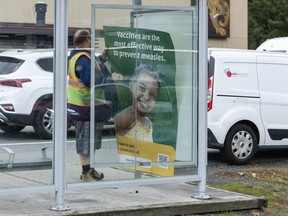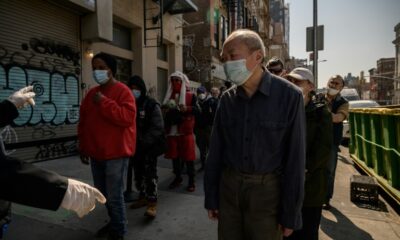Health
B.C. Childhood Vaccination Rates Stagnate Post-COVID-19

Vaccination rates for children in British Columbia have not rebounded from a decline that began during the COVID-19 pandemic. Data from the B.C. Centre for Disease Control (BCCDC) indicates a significant drop in routine vaccinations, particularly for younger children.
The most recent statistics reveal a “small-to-medium decline” in vaccination rates since 2021, as stated by Dr. Jia Hu, the interim medical director of immunization programs at the BCCDC. Specifically, over one-third of second-graders are not current on routine immunizations for diseases such as mumps and measles. The overall vaccination rate for children has decreased by nearly 10 percent from 72.5 percent in 2021 to 63.8 percent in 2024.
The ongoing effects of the pandemic, when access to vaccines was challenging, contribute to this trend. Dr. Hu noted that the number of children with documented refusals—parents indicating they do not want their children vaccinated—has remained consistent in recent years. This stability suggests that the actual immunization rate may be higher than reported, especially as some children vaccinated in other provinces or countries may not have their records updated in B.C.
An increase in migration during and after the pandemic may have led to incomplete health records for some families, further complicating the data landscape. Nevertheless, Dr. Hu emphasized that the available data is useful for identifying trends on a broader scale.
Despite the decline among older children, a comparison of immunization coverage for younger children reveals a concerning trend. In 2024, only 69.5 percent of two-year-olds in B.C. were up-to-date on routine vaccinations, a decrease from previous years when rates for this age group consistently ranged between 73 and 74.3 percent from 2016 to 2020.
Increasing vaccine hesitancy is part of the problem, with a 2024 poll by Angus Reid indicating that one in six Canadian parents of children under 18 are “really against” vaccinating their kids. This represents a sharp increase from 2019, when just under 8 percent expressed similar sentiments. The proportion of parents who were “unsure” about vaccinations also doubled during the same period, raising concerns among health officials.
Dr. Brian Conway, medical director of the Vancouver Infectious Diseases Centre, described this trend as “a disaster of epic proportions.” Despite these challenges, the BCCDC has observed a gradual improvement in vaccination rates for older children, particularly by Grade 6 and Grade 9. Public health clinics in schools provide scheduled vaccinations and catch-up shots for those who have missed their appointments.
Dr. Hu noted that immunization rates for measles, mumps, and German measles have seen a “dramatic increase” in recent months, with a 30 to 40 percent rise in uptake compared to the previous year. This surge is likely attributed to a rise in measles infections, with 102 cases reported across the province as of July.
Despite this positive trend, measles immunization coverage in 2024 remains at only 70 percent for seven-year-olds, while coverage for other vaccines, like German measles and hepatitis B, exceeds 80 percent.
To address low vaccination rates, health officials are targeting specific regions that show the greatest need for improvement. According to the BCCDC immunization dashboard, the Kootenay Boundary region had the lowest vaccination coverage for seven-year-olds in 2023, at 54 percent. The Okanagan region followed closely at 60 percent. In contrast, the Northern Interior of Northern Health recorded the highest rate at 75.6 percent.
In an attempt to further improve vaccination rates, the province is looking to enhance human papillomavirus (HPV) vaccine coverage. Health officials aim to simplify the vaccine schedule and expand eligibility for individuals aged 19 to 26, emphasizing the vaccine’s role in preventing HPV-related cancers. In 2023, the HPV vaccination rate for females in Grade 9 was 60 percent, while the rate for males was 57.7 percent.
As part of ongoing vaccination efforts, the province has begun sending notifications for seasonal flu and COVID-19 vaccine appointments, which are available at no cost. The first vaccinations were administered to British Columbians earlier this week.
In summary, while there are indications of improvement in certain areas, the overall stagnation in childhood vaccination rates in B.C. poses a significant public health challenge that requires continued attention and action from health officials and the community.
-

 Lifestyle2 months ago
Lifestyle2 months agoWinnipeg Celebrates Culinary Creativity During Le Burger Week 2025
-

 Health2 months ago
Health2 months agoMontreal’s Groupe Marcelle Leads Canadian Cosmetic Industry Growth
-

 Science2 months ago
Science2 months agoMicrosoft Confirms U.S. Law Overrules Canadian Data Sovereignty
-

 Education2 months ago
Education2 months agoRed River College Launches New Programs to Address Industry Needs
-

 Technology2 months ago
Technology2 months agoDragon Ball: Sparking! Zero Launching on Switch and Switch 2 This November
-

 Science2 months ago
Science2 months agoTech Innovator Amandipp Singh Transforms Hiring for Disabled
-

 Technology2 weeks ago
Technology2 weeks agoDiscord Faces Serious Security Breach Affecting Millions
-

 Technology2 months ago
Technology2 months agoGoogle Pixel 10 Pro Fold Specs Unveiled Ahead of Launch
-

 Science2 months ago
Science2 months agoChina’s Wukong Spacesuit Sets New Standard for AI in Space
-

 Technology2 months ago
Technology2 months agoWorld of Warcraft Players Buzz Over 19-Quest Bee Challenge
-

 Education2 months ago
Education2 months agoAlberta Teachers’ Strike: Potential Impacts on Students and Families
-

 Business2 months ago
Business2 months agoDawson City Residents Rally Around Buy Canadian Movement
-

 Technology2 weeks ago
Technology2 weeks agoHuawei MatePad 12X Redefines Tablet Experience for Professionals
-

 Business2 months ago
Business2 months agoNew Estimates Reveal ChatGPT-5 Energy Use Could Soar
-

 Science2 months ago
Science2 months agoXi Labs Innovates with New AI Operating System Set for 2025 Launch
-

 Technology2 months ago
Technology2 months agoInnovative 140W GaN Travel Adapter Combines Power and Convenience
-

 Technology2 months ago
Technology2 months agoFuture Entertainment Launches DDoD with Gameplay Trailer Showcase
-

 Technology2 months ago
Technology2 months agoGlobal Launch of Ragnarok M: Classic Set for September 3, 2025
-

 Education1 month ago
Education1 month agoBrandon University’s Failed $5 Million Project Sparks Oversight Review
-

 Business2 months ago
Business2 months agoBNA Brewing to Open New Bowling Alley in Downtown Penticton
-

 Technology2 months ago
Technology2 months agoNew IDR01 Smart Ring Offers Advanced Sports Tracking for $169
-

 Technology2 months ago
Technology2 months agoArsanesia Unveils Smith’s Chronicles with Steam Page and Trailer
-

 Science2 months ago
Science2 months agoNew Precision Approach to Treating Depression Tailors Care to Patients
-

 Technology2 months ago
Technology2 months agoHumanoid Robots Compete in Hilarious Debut Games in Beijing










